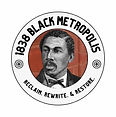There was a Black Lutheran Church on Quince in 1838 and historic things happened there
- Michiko

- May 13, 2023
- 2 min read
Battles for freedom in the South led to free Black refugees pouring into Philadelphia in the early 1830s
Historian Julie Winch notes that following the Denmark Vesey and Nat Turner battles for freedom in the South, in which enslaved people rose up to battle plantation owners in order to escape bondage, it became much harder for free Black people to live in the South.

After the Turner uprising in 1831, "most of the refugees from Charleston had fled to Philadelphia" and "...as many as five hundred southern freemen had settled in the city in two months" (Winch, 131).
The first Black Lutheran Church was launched in the Black Metropolis in 1833
Jehu Jones was part of this refugee movement. When he first came to Philadelphia 1833, he worked for a short time at St. Thomas African Episcopal Church but then he decided to start his own Lutheran denomination. Jehu Jones became the first Black ordained Lutheran pastor in the United States.
Black Lutherans built their own church building and it's still standing
In 1834 he took a mortgage out for a church building on Quince street. He received no financial support from the Pennsylvania Synod of the Lutheran Church (Synod) and so the church was built entirely with funds by Black congregants.
We also believe that the building itself was most likely built by Black masons and construction workers.

Photo courtesy the Lutheran Quarterly
Quince is a quiet, lovely alley. It was once a center for Black life, a key corridor in the middle class Black neighborhood that is now called Washington Square West

Free Black men exercising their right to vote in 1837 led to a situation where the all white Pennsylvania Legislature removed the right to vote. But the Legislature didn't take away the duty to pay taxes - true taxation without representation .
In 1838, during the fight to prevent the loss of the right to vote. the Black community came together in ways they had not done before; across religious and class boundaries. One of the very important planning meetings was held in St. Paul's Lutheran Church.

When we stand outside the church we like to imagine our Black leadership meeting and talking right on Quince.
The building was purchased and renovated by Penn and turned into the Mask and Wig drama club and in 2016, Black Lutherans dedicated the site with a historical marker.
Learn more about the Black Families on Quince in 1838. Click here to go to our interactive dashboard.
References
Ministry Link
Purvis, Robert
Synod
Winch, Julie,







